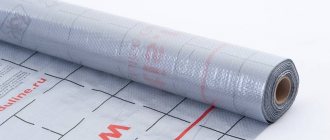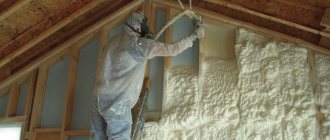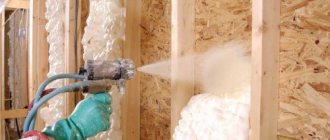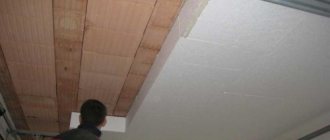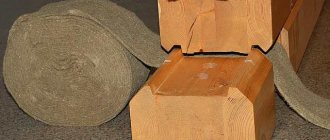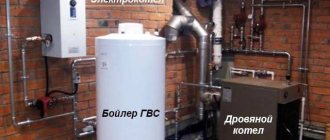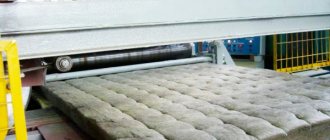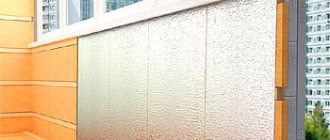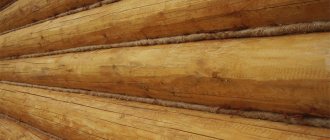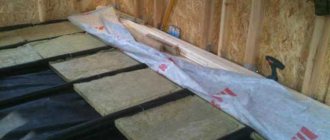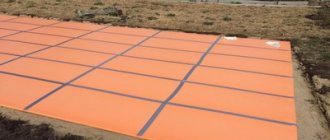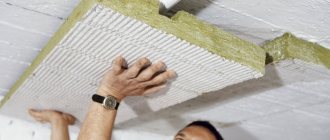Purpose of interventional insulation
Inter-crown insulation is a special type of heat-insulating materials that are laid between the crowns of a wooden building (house, bathhouse, utility room) to eliminate gaps. They can be loose (tow, moss) or in the form of ribbons (felt, batting).
The main task of such insulation is to create comfortable living conditions inside the house. Interventional insulation creates a favorable microclimate only if it can:
- keep the house warm in winter and prevent it from overheating in summer;
- avoid drafts;
Insulation of a log house with moss.
- compensate for changes in the linear dimensions of wood that appear during drying or swelling during changes in environmental humidity (so that cracks do not appear);
- protect owners from unnecessary noise;
- prevent insects from appearing in the house;
The main functions of interventional insulation.
- prevent the colonization of inter-crown space by microorganisms.
In order to perform its assigned functions, inter-crown insulation for timber (logs) must have a certain set of quality characteristics.
What is good insulation?
The main purpose of interventional insulation is not only to prevent heat loss, but also to create a comfortable and favorable microclimate indoors, so it must have the following characteristics:
- reliably protect the building from drafts and frost;
- have sufficient density and elasticity so that cracks do not form in it during operation;
- have good vapor permeability and moisture absorption ability;
- do not contain substances or impregnations harmful to the body;
- do not contribute to the proliferation of microorganisms and fungal spores;
- have resistance to the effects of negative factors;
- do not change its performance properties over a long period of time.
Intercrown insulation will keep your wooden house warm and cozy
In addition, when choosing an interventional beam, you should take into account the qualities and features of the material from which the building is constructed, as well as its main purpose - a residential building, a bathhouse, an outbuilding.
Operational Requirements
High-quality insulation for the crowns of a wooden house must have:
- low level of thermal conductivity to ensure minimal heat loss - the best performance for natural materials;
- high vapor permeability - the walls must breathe, ensuring natural air exchange between the street and the room;
- the ability to absorb moisture well and quickly release it (dry), which allows you to maintain the same moisture content of the timber or log around the entire circumference (the processes of the occurrence of multidirectional stresses inside the timber, leading to its cracking, and the appearance of mold (rot) between the crowns are eliminated). The best in this indicator are flax and jute, but synthetic heat insulators do not absorb liquid - it remains on the fibers. Therefore, artificial insulation materials are not used in bathhouses - the walls will begin to rot;
- uniform density - there will be no cold bridges;
- high elasticity, which allows you to tightly close the gap between the crowns when the house shrinks and the walls swell or dry out;
- resistance to fungus and mold;
- resistance to ultraviolet radiation (sun) and the vagaries of nature (rain, snow, heat, frost);
- long service life comparable to the durability of a house;
- optimal ratio between thickness and density (indicators are given in Table 1);
Table 1. Optimal ratio of thickness and density.
| Thickness, mm | Density, g/m2 |
| 5 | 400 |
| 6-7 | 600 |
| 8-10 | 600-700 |
| 10-15 | 800 |
- environmentally friendly - does not contain components harmful to health;
- sufficient tape width. There are 2 rules here.
- At frost temperatures of -20oC, the width of the thermal insulator should be at least 10 cm, -30oC - 12 cm or more, -40-50oC - 14-18 cm.
- Insulation that is 5 mm smaller in width than the groove will help you get a beautifully designed inter-crown space. If further insulation of the gap is planned with the same material (caulking), the tape should be 10-15 cm larger than the contact area of the crowns.
Artificial materials
When answering the question - how to choose inter-crown insulation for timber, you cannot ignore artificial materials. Today this option is the most popular. One of these materials is called “holofiber”.
This insulation is made from polyester fibers using the non-woven method. The material is produced in rolls and plates, each type has its own density.
Holofiber has high elasticity. This feature is very convenient for thermal insulation of crown joints, especially when using laminated veneer lumber or non-profiled timber.
This material has no pores, which means it can warp when drying. If insulation made from natural material is used, then the appearance of cracks is inevitable. When using holofiber, additional sealing of the crown joints after the timber has dried is not required. The fibers of this material will fill the cracks that appear on their own.
Holofiber does not absorb water and retains its thermal insulation properties
In addition to a high degree of elasticity, holofiber has a number of other advantages. Experts include the following among the most significant of them:
- has low water absorption rates, less than one percent. This means that holofiber will not absorb moisture and will retain its thermal insulation properties longer even in a humid climate;
- the material does not burn even at high temperatures. This property is very important for thermal insulation of wooden buildings;
- Insects “don’t like” the material; they definitely won’t live here. In addition, holofiber is not afraid of mold;
- not only has high thermal insulation properties, but is also an excellent sound insulator;
- Holofiber has a long service life, and even over time does not require additional caulking.
You should not think that holofiber can have a detrimental effect on human health. This material does not cause allergies, does not emit harmful substances and is absolutely environmentally friendly. There can only be one drawback. If wood that was too damp was used during construction, it may be prohibited. Holofiber does not allow the walls of the house to “breathe”.
Another common inter-crown insulation for wooden houses made of profiled or laminated timber is “shelter”. This material is made from polyester fiber. Just like holofiber, it has high elasticity, which allows you to fill all the cracks newly formed as a result of shrinkage of the house. Shelter does not rot, does not absorb moisture and retains heat perfectly.
There are also more modern materials, for example, “polytherm”. At its core, it is a type of holofiber, but with greater elasticity. According to the manufacturers, the material can last 50 years. But polytherm appeared not so long ago, only about ten years ago, so it is not possible to test this in practice.
Inter-crown insulation “Polytherm” can last up to 50 years
Synthetic insulation
Synthetic thermal insulation for the gaps between the crowns of the wall is represented by polyester fibers. The general advantages of this type of insulation include:
- durability - manufacturers talk about a service life of 100 years;
- low thermal conductivity coefficient;
- vapor permeability;
- elasticity (volume is restored by 90% after prolonged compression);
- frost resistance.
There are two disadvantages:
- high cost of 1 linear meter;
- do not absorb water, as a result of which a greenhouse effect occurs indoors, and the wood becomes moldy. Therefore, good ventilation of the house and careful wood processing are needed.
The result of using low-quality synthetic inter-crown insulation is fungus at the joints of the crowns.
The best representatives in the segment of synthetic insulation are “Holofiber” and “PoliTerm”.
"Holofiber"
Inter-crown insulation “Holofiber” (translated as “hollow thread”) is one of the varieties of padding polyester known to everyone. It is a springy polyester fiber molded into a tape that perfectly adapts to changes in the linear dimensions of wood during deformation due to shrinkage or changes in humidity. This property is especially valuable for a log house made of sawn timber without grooves. The insulation perfectly holds the volume, ensuring complete tightness, so that re-caulking is not done.
Holofiber insulation.
It goes on sale in rolls and sheets of different densities and elasticity, which allows you to make a choice based on the characteristics of the wood.
Among the advantages :
- excellent elasticity;
- good noise and thermal insulation properties;
- long service life;
- simple installation;
- no need for re-caulking;
- environmental cleanliness;
- resistance against negative biological factors (birds do not carry, insects do not appear).
Negative include :
- “biting” price;
- artificial origin;
- there is a risk of mold or a special type of rot, about which people say: “the tree is rotting.”
"PolyTerm"
Insulation of gaps between the crowns of a wooden house "PoliTerm" is the result of the work of Finnish technologists. Let us immediately note two features:
- when developing the heat insulator, “Holofiber” was taken as a basis, as a result, the result was a type of padding polyester insulation;
- short production period (appeared on the market about 10 years ago), and therefore we cannot give an objective assessment of the advantages and disadvantages of the material (manufacturers can say whatever they want).
What is beyond doubt is:
- convenient release form - in the form of an adhesive tape;
- resistance to any vagaries of nature;
- high price (10-12 times more expensive than jute tape);
- lack of vapor permeability.
Insulation "PolyTerm".
Sold in the form of tapes with a width of 30 to 250 mm and a thickness of 80-200 mm.
Interventional insulation for timber: which one to choose?
In a wooden house built from timber or logs, an amazing atmosphere is always created, which has a beneficial effect on the psychological and physical state of the residents, and this is due to the properties of natural wood. In order for such a home to be warm, and not be blown out by strong winds and not freeze in winter, its walls must be well insulated, choosing the appropriate material for this process.
Interventional insulation for timber: which one to choose?
Which inter-crown insulation for timber should you choose in order to achieve all your goals at once? This question arises for everyone who has started building a log house for a house. Since log buildings have been built for centuries, only natural materials have always been used to insulate such walls. This tradition has passed on to the present day, although today a considerable number of artificial heat insulators are produced - they have not been able to fully replace the natural ones that were traditionally used by builders.
If the construction of a log house is entrusted to a construction team, then it would be useful to keep the entire work process under control and independently select and purchase all the necessary auxiliary materials, including inter-crown insulation. Otherwise, you may end up with poor-quality work, which sometimes simply cannot be corrected without a complete overhaul of the entire frame.
For what purposes is interventional insulation used?
To understand how important it is to choose the right and high-quality insulation, you need to fully understand why it is needed when building a wooden log house.
Interventional insulation performs several important functions at once
Inter-crown insulation is required:
- To preserve and enhance all the thermal insulation qualities of wood, as well as to maximize the life of the building.
- To avoid the penetration of moisture between logs or beams, with the subsequent emergence and development of mold or mildew, nests of unwanted insects in the house.
- To ensure vapor permeability, since wood is a breathable material and responds to increased humidity and temperature changes. Therefore, inter-crown insulation is mounted not only between beams or logs, but also around window frames and door frames.
In the presence of correctly selected and installed insulation, a residential building acquires the following qualities necessary for it:
- low thermal conductivity, since the walls will not have cold bridges;
- resistance to strong winds, because the walls become windproof;
— balance of moisture absorption and moisture evaporation.
As you can see, this seemingly insignificant element at first glance has a serious impact on both the quality and overall durability of the building.
Which insulation for crowns to choose?
Previously, when constructing wooden log houses, waste materials produced at home from various plants were used for insulation. The main one was flax, the fibers of which are a good “breathable” heat insulator. As you know, fabric was made from flax, and the rough parts of the plant unsuitable for it were turned into insulation for the walls of the house.
In addition to flax, moss was used to seal the joints of logs, which could be found in large quantities in the forest and in swamps.
Another popular insulation used to close gaps between logs is felt, which was made from sheep's wool, compressed and then cut into strips of the desired width and thickness.
These materials are in perfect harmony with wood, so the hut insulated with them served without additional repairs for many decades.
Today in specialized stores you can find many different artificially produced materials that manufacturers offer instead of traditional ones. They have a lower price than natural insulation, so many owners who are inexperienced in construction purchase them, not knowing the consequences of such use. Such materials include polystyrene foam, mineral wool, silicone sealants or penofol. Modern artificial insulation materials, of course, have their advantages, and in some cases you simply cannot do without them, but they are absolutely not suitable for laying between the crowns of logs or beams.
Video: a brief overview of inter-crown insulation
Natural interventional insulation
Linen wool for insulation of crowns
Blooming flax
As can be understood from the name of the insulation, it is made from flax; it is also often called linen felt. It remains popular today, as it meets all the requirements necessary for interventional insulation:
- This is an environmentally friendly natural material, so it does not cause allergies even in people with a predisposition to it.
- Today flax wool is made not from flax waste, but from purified raw materials, therefore, thanks to its components, the insulation is able to create a microclimate that is favorable for the health of residents.
- This insulation ensures uniform compaction over the entire width and length of the crown.
- It perfectly blocks wind flows.
- Linen wool does not attract dust and does not fray on its own.
- The material is able to adequately respond to fluctuations in humidity - it either accumulates or releases excess moisture, thereby maintaining an optimal balance.
- Linen wadding is a breathable, vapor-permeable material.
- It provides a high level of thermal insulation and sound insulation due to its good adhesion to the wood.
- This insulation is very easy to install.
Rolls of flax wool
Linen batting is a non-woven material made by pressing and cut into strips of a certain width, which can vary from 8.5 to 200 mm. The thickness of the material is 5 ÷ 7 mm, the length of the strip in a roll is usually 2000 mm.
If the insulation does not have the required density, then it is laid in two or three layers, securing the logs to the crown with staples.
Temporary fixation of insulation with stapler staples
The edges of the insulation should not extend beyond the crown, otherwise, after installing the logs, they will have to be hammered into the cracks. It is recommended to think through this point in advance and carefully bend and secure the edges inside when laying the next crown.
How to properly lay tape inter-crown insulation
You need to know that when using flax wool, it is recommended to cover the joints of the logs after installation with a decorative cord made of jute so that the seams look aesthetically pleasing, and this will lead to additional costs.
Flax wool also has negative sides:
- it can become a breeding ground for various insects, such as moths, wood borers, bedbugs and others;
— birds happily use this material to build nests, plucking out pieces of it from the gaps between logs, which leads to mandatory repairs, in which the seams need to be stuffed with insulation again.
Therefore, when using flax wool, you need to coat the beams or logs very well with an antiseptic before laying it.
Moss as inter-crown insulation
Insulation such as moss has been used for laying between crowns since ancient times. They have not abandoned its use today, since it is still considered the most reliable and affordable material.
Since ancient times, moss has been used as insulation for log houses.
In regions where log buildings were traditional, moss grew almost everywhere, which is why it was the only insulating material for inter-crown sealing. Houses insulated with moss served for decades without repair, and even when they were dismantled after many years of use, one could notice that the logs were kept in perfect condition and were suitable for constructing a log house in another place.
Moss protects log houses from rotting and damage
In total, there are about 300 different types of moss, but only two of them, called “sphagnum” and “cuckoo flax,” are suitable for insulating wooden log houses. These representatives of the flora contain a large amount of antiseptic substances that resist putrefactive processes well. Penetrating into the wood, flavonoids disinfect its fibers, thereby preventing them from decomposing.
Prices for interventional insulation
Intercrown insulation
A log harvested with moss has an amazing aroma of the forest, which creates a special microclimate in it. Since the material is environmentally friendly and non-allergenic, it is safe for humans. In addition, many people suffering from asthma, lung diseases, dermatitis and other ailments feel significant relief while in such a house.
Moss is especially suitable for insulating walls made of hand-processed logs, since they do not have perfectly even crowns. In this case, the moss can be laid unevenly - in some places a thicker layer, in others a very thin layer, which is difficult to do using tape material.
- Sphagnum moss is a low-growing plant with soft, small, light green leaves and long, fibrous roots. This type of moss has more antiseptic components than cuckoo flax, so herbalists used it to treat non-healing wounds, as it works on a par with the well-known brilliant green or iodine.
The optimal choice for insulation is sphagnum moss
As an insulation material, this type of moss is distinguished by its high density and elasticity. It perfectly maintains the moisture balance of wood and does not respond to temperature changes. In addition, sphagnum is not afraid of ultraviolet radiation, does not dry out from it and does not lose all its heat-insulating properties.
Sphagnum grows in damp swampy areas or forest thickets. It covers the soil with a soft carpet, and it is quite simple to collect, but it is recommended to carry out this activity in sunny, dry weather. After collection, the moss is piled in small bunches to dry for a short time. Drying time takes one to two weeks, depending on the moisture content of the raw materials, and this, in turn, will depend on the place and time of collection of the plants.
Laying sphagnum on crowns is quite complicated and not as convenient as when using ready-made tapes of other insulation materials. But this approach is most effective for thermal insulation and protecting the log house from various negative natural influences.
- Kukushkin flax is a hard, long-fiber, brown-colored moss. When dry, it acquires a reddish tint. You can find this plant the same way as any moss - in a damp, swampy area or in the thicket of a forest. If cuckoo flax is collected for use as insulation, then it is better to look for it in the forest, since there it is not so saturated with moisture.
This is what a growing cuckoo flax looks like
Unlike sphagnum, cuckoo flax is recommended to be collected in cloudy weather, so it will better preserve its qualities. After collection, this type of moss is laid to dry in long strips, which, after drying, can be laid on the crowns of logs. It should be remembered that cuckoo flax is not dried thoroughly, since when laying it must have a certain percentage of moisture. If the raw material accidentally dries out, then it needs to be slightly moistened during installation. However, cuckoo flax is often laid even when freshly harvested.
Collected cuckoo flax
The process of inter-crown compaction is carried out in 4 ÷ 5 layers, each of them being laid perpendicular to the previous one. When laying logs on the insulation, the material should be held, as this process requires care. Upon completion of the work, the moss left hanging outside must be caulked into the joints of the logs using a chisel.
Laying out moss when installing a log house
Kukushkin flax has good density and does not crumble when dried. It is not subject to putrefactive processes, is not afraid of high humidity and retains all its insulating qualities for the entire period of its operation.
This insulation also has its drawbacks, which should be taken into account when choosing it - low fire resistance, as well as heterogeneity and friability of the material, which makes it difficult to install. In addition, it is one of the favorite food for birds. To protect the insulation from birds, it must be tucked well into the seams between the logs and covered with jute rope on top.
Jute insulation
Another effective insulation for crown joints is jute, made from a tropical annual plant of the linden family of the same name, the fibers of which have a high percentage of lignin content. This is the name of a unique resin, which is an excellent natural antiseptic that can protect not only the insulation itself, but also the material of the timber or logs.
Preparation of jute raw materials
Thanks to this component, jute material is resistant to moisture, which means it is not susceptible to putrefactive processes. It is not taken away by birds or damaged by rodents, which is also very important for high-quality insulation of a residential building.
Jute insulation in our time is often produced in the form of a tape with a width of 100, 120, 150 and 200 mm, and a thickness of about 15 mm. The density of material of this thickness is 400 ÷ 450 g/m². The insulation tapes are rolled into rolls of 2000 mm.
Roll of jute tape insulation
In addition, ropes are made from jute, which are also used to decorate the inter-crown seams of log or timber frame houses.
Jute has a golden hue that harmonizes perfectly with the color of the fibers of any type of wood.
However, paradoxically, the disadvantage of pure jute insulation is its main advantage - very often an excess of lignin contributes to the gluing of its fibers, causing the material to lose its plasticity and become rough and rigid. Therefore, jute is combined with flax fibers, which are also used to insulate crowns.
So, several combined options are produced:
- flax jute (jute-flax);
- jute felt.
- Linen jute is made from flax and jute fibers. Their ratio may be different for each individual manufacturer, therefore the characteristics of the insulation may vary somewhat.
Proportions of 1:1 are considered ideal, since the resulting material combines the elasticity and softness of flax, as well as the rigidity and strength of jute. Flax fibers are located inside the tape, and jute acts as a protective layer - the result is a durable and plastic insulation.
Therefore, the combined material is considered the optimal insulation material, especially for objects that are problematic in terms of high humidity, such as saunas and Russian baths.
- Jute felt is also made from flax and jute, but in a ratio of 10% to 90%. In this embodiment, the two components are mixed together. Linen dilutes the rigidity of jute and prevents its fibers from sticking together, which has a beneficial effect on the insulating and antiseptic qualities of the material.
Like any tape insulation, jute is easy to install. The main thing is to choose the right ribbon width for the crown.
Rolling jute insulation along the crown
The tape is rolled out on the crown, and if overhangs form, they need to be folded and stapled using a stapler. Experts advise choosing the width of the tape slightly larger than the size of the crown, and making bends during installation - this process will give a neat appearance and the necessary thickening to the insulating layer.
Insulation - tow
Tow is made from different materials - it can be flax or hemp, and consists of processed fibers from these plants. These fibers are sometimes pressed into strips and are also used to insulate crowns, having good thermal insulation properties.
Tow is a long-known, but, alas, not the best insulation material.
Despite its good insulating properties and affordable price, tow has not become such a popular material for insulating crowns. One of the reasons for this lack of demand can be called the great love of birds for this insulation. Its fibers are easily separated from the total mass, so birds willingly take advantage of this when building nests in the spring.
After such raids, the seams have to be repaired annually. If this material is used, it is recommended to cover it from the outside with jute rope.
It should be noted that tow is more hygroscopic than other insulation materials - it absorbs moisture and is susceptible to rotting. It is advisable to use it indoors with normal humidity, so it is more often used to insulate window and door openings if the windows and doors are made of wood.
From the above we can conclude that any tow is not the best choice for insulating crowns.
Sheep wool (felt)
Sheep wool has long been used as insulation, especially in those countries where sheep breeding is developed. Over time, such insulation began to be produced on an industrial scale and exported throughout the world.
Natural felt made from sheep wool is an excellent material for insulating a log house.
This material is made from raw materials purified and treated against insects by mixing and combining wool and felt fibers into one sheet.
The insulation is produced in thicknesses from 12 to 18 mm, widths from 90 to 200 mm and has very high heat-insulating and sound-proofing properties.
- Thanks to its elastic and springy structure, the insulation fills the entire inter-crown space, leaving no cold bridges. When the walls shrink or the gaps between the logs expand, it is able to shrink and straighten.
- Natural felt does not cake or compact over time, and therefore does not lose its original qualities.
- Sheep wool perfectly accumulates moisture, promoting good vapor permeability of seams, therefore it is not affected by fungal formations and does not rot.
The only drawback of this material can be considered its high price, since mainly only imported samples are on sale.
Artificial insulation
Manufacturers also offer artificial insulation for inter-crown insulation. Some of them, more or less suitable for this process, are also worth considering.
"PolyTerm"
They characterize it as an environmentally friendly heat-insulating material, since it is made from 100% polyester fiber. Its production technology was developed in Finland, where it has been successfully used in harsh subpolar climatic conditions for a long time.
Insulation of a log house with "PolyTerm"
"PolyTherm" is widely used as inter-crown insulation for residential buildings, for saunas and baths.
The positive qualities of the material include the following:
- This material is “breathable”, which means it will harmonize well with the structure of the wood. “PolyTherm” is not hygroscopic and has the ability to repel moisture, so when using it, you don’t have to worry about additional sealing work.
- The insulation has vapor-permeable properties, that is, it does not interfere with the natural exchange of gases and vapors.
- Thanks to the mentioned advantages, the insulation tape does not create a favorable environment for the development of microflora. Unlike natural materials, PolyTerm is unattractive to birds and various insects.
- The material is elastic and resilient, so when the walls shrink or the wood dries out, it straightens out and fills the resulting space.
- "PolyTerm" has high fire resistance.
- Its most important quality is its low thermal conductivity coefficient.
- The material does not contain harmful phenol-formaldehyde compounds.
- The chemical composition of the fibers does not cause allergic reactions in the body.
Roll "PolyTerma"
Manufacturers claim that PolyTerm may well not only replace natural materials in inter-crown insulation, but even perform their function at a higher level.
Video: “Holofiber” is a representative of synthetic inter-crown insulation for a house made of timber.
Latex sealant
To insulate wooden buildings, sealants made on various bases are also used. One of them is “Consil”, which is intended specifically for inter-crown insulation and sealing natural cracks in logs or beams caused by drying out of the wood.
Cans and tubes of latex sealant "Consil"
"Consil" is a one-component sealant made on a latex basis and used for external and internal work related to wood.
Sealing the joints of a log frame with sealant, ...
- Latex sealant allows you to normalize the humidity and temperature conditions, which are comfortable for living inside a log structure.
... or grooves in a log house made of profiled timber
- This material perfectly restrains wind flows, so the walls become windproof and there will never be drafts in the house.
- Thanks to the sealant, there is absolutely no heat leakage, so it is retained in the house, which can significantly reduce heating costs.
- Seams sealed with Consil do not require periodic repairs - caulking, which must be carried out periodically if natural tape insulation is used.
- The sealant ensures reliable closure of roof gaps and cracks from the penetration of various insects into the house.
- The insulation is produced in a variety of colors, so you can always choose the right option for a specific type of wood.
This is what the diagram of a poorly insulated log house looks like. It shows what problems can arise with the wood of the logs, as well as how serious heat leaks will occur from the room.
Schematically - what poor-quality insulation of a log house leads to
Since a poorly sealed roof gap is not protected from atmospheric influences, the risk of dampness and mold, insects, wind and sounds from outside entering the house, as well as cold in winter and hot air in summer increases.
When insulating, be sure to seal any cracks that have formed.
If the roof gaps and cracks in the logs are sealed reliably, the house can be considered protected from all the problems mentioned. The heat generated by heating devices remains completely inside the house, and street cold or heat will have no bridges to penetrate inside.
Application of the sealant is quite simple, since it has aggressive adhesion to wooden surfaces, literally being absorbed into them. Good adhesion of materials is maintained throughout the entire period of operation of the building, since “consil” is not affected by low and high temperatures.
The sealant remains elastic and is able to change size and shape many times, under the influence of expansion and drying of wood or shrinkage of walls.
It is impossible not to mention the moisture resistance of this material. After hardening, it is not exposed to atmospheric precipitation, does not allow water to pass through and is not washed out of the gaps by it. In addition, the sealant is resistant not only to temperature changes, but also to the ultraviolet component of sunlight.
Based on the results of tests carried out on the effect of the sealant on various temperatures, an aqueous environment, ultraviolet radiation and deformation by 50%, manufacturers predicted the service life of the material - it is 30 years or more.
The nuances of laying inter-crown insulation
Whatever insulation for the crowns is chosen, its installation follows the same pattern. Naturally, it is much easier to secure the tape material than to lay out moss or tow, but both works are carried out according to the same principle.
- The tape insulation is rolled out on the surface of the laid log and fixed with staples. If the insulation is wider than required, its edges are wrapped and also secured with staples.
- If the edges of the insulation were not folded inward before laying the next log on top of it, then after completion of the work, this excess is driven into the cracks using a chisel. This process is called primary caulking.
- Secondary caulking is carried out a year later, after the walls have shrinked.
- When using moss or tow for insulation, the material is carefully laid out on the crown, in a layer of 10 ÷ 15 mm, pressing it to the base.
Laying out a layer of moss
- After laying the insulation on top of the logs, the fibers hanging on the sides (usually an allowance of about 50 mm in each direction) are also tucked into the gaps between the logs using the same chisel.
- Sometimes insulation is combined using tape insulation, which is rolled out over a beam or placed in a special groove, and a sealing jute cord is laid along its edges. After installing the top log, the gap between the logs on the street side is filled with sealant. The gap between the logs on the inside of the wall can be carefully caulked with one of the natural materials.
Caulking of intercoronal seams from the inside
Now, knowing the characteristics of most of the materials used for insulating crowns, you can study them well, compare the price level in the region of residence or the possibility of independent procurement, and, in the end, settle on the most optimal option. All that remains is to correctly carry out the insulation process yourself or check the conscientiousness of the builders’ work to ensure that the material is laid correctly.
You may be interested in information about the dimensions and technical characteristics of penoplex insulation. Study the calculator for calculating a boiler for heating a house using the link.
Popular manufacturers and prices
On sale inter-crown insulation made from natural plant fibers are represented by the following brands: “Thermo-Hanf”, “Val-Flax”, “ThermoLen” (“ThermoJUT”), “Flaxan”, “Ekoteplin”, “Ecoterm”, “Ekolen”, etc. ., both Russian-made and European manufacturers. More detailed information about them is given in the work: “Review of flax insulation.”
Let us separately note the prices. So, for 1 linear m with a thickness of 5 mm, a width of 15 cm and a density of 450 g/m2 must be laid out for products from:
- flax - 11 rubles;
- jute - 13 rubles;
- jute mixed with flax - 12 rubles.
With changes in thickness and width, as well as density, prices also change.
Synthetic insulation is produced by:
- "Holofiber" - enterprise "Thermopol" (Moscow);
- "Polytherm" is a center for inter-crown insulation (Moscow).
For comparison, we present the price per 1 linear meter. the same parameters as natural fibers - 32.7-43.6 rubles.
Insulation made from plant fibers
Jute
Jute interventional insulation
Jute is one of the most popular insulation materials today. It is made from a plant that can be found in southern latitudes. In its composition, the material is very close to wood, durable and very hygroscopic, therefore it is absolutely not afraid of moisture and can be used to insulate baths. Jute also has good decorative properties - a beautiful golden color that looks great against the background of wooden walls. It is this color that is an indicator of the quality of jute - some manufacturers add flax fibers to the material, which is why it becomes soft, grayish and significantly loses quality. This jute has a low density and cakes much faster.
Jute
Another common inter-crown insulation is the so-called “lush” jute. It attracts the attention of buyers due to its thickness and low cost. However, all the “pomp” will very quickly disappear under the weight of the building, and the connection of fibers in this case is carried out using thermal bonding using synthetic materials.
To choose the right insulation from jute fibers, you should take into account the required thickness of the material, which directly depends on the characteristics of the surface of the logs (dryness, evenness, etc.).
- For wooden houses made of glued and ordinary timber, it is recommended to use material with a thickness of 5-6 mm and a density of 400 g/m2.
- For buildings made of rounded logs, you will need insulation with a thickness of 8-10 mm and a density of 600 g/m2. You can use another option, 5-6 mm thick and 400 g/m2, which is laid in two layers.
- For log houses made of wood, it is recommended to take insulation with a thickness of 15-18 mm with a density of 800 g/m2. It is allowed to use material with a thickness of 8-10 mm and a density of 600 g/m2. in two layers.
This is what high-quality inter-crown jute insulation looks like
Inter-crown insulation made of jute is offered to customers both in the form of tapes and in the form of tow or ropes. The latter option is very popular today, as it gives the building an attractive and finished look.
Jute tow
Jute ropes
Linen
Interventional insulation made from flax fibers is cheaper than jute fibers, and has a number of advantages and disadvantages. Linen is absolutely safe for humans (sometimes it is even called healthy), quickly absorbs and releases moisture, does not accumulate static electricity and does not promote the proliferation of microorganisms. There are no hard or prickly impurities in the material, so all work can be done manually.
Inter-crown insulation flax
The most budget option is flax tow, which can be found on any construction market. Its disadvantages are that laying in this case is a rather labor-intensive process (it will have to be distributed manually, which is quite a difficult task), the material can rot, and subsequently birds can take it away. In addition, linen insulation often harbors moths, which gnaw through the material, and when performing finishing work, it can wrap around the drill.
Linen tow
A more expensive, but at the same time practical solution is linen insulation in the form of tape, since it is much easier to install, and the reliability of the material is much higher. The material can have different widths, and also does not require preparatory work - it can be laid immediately.
Hemp
Linnet - natural inter-crown insulation
Hemp is also one of the oldest materials for insulating wooden buildings (even the name of the plant itself comes from the word “caulk”) - a material called hemp is made from it. Its disadvantages are exactly the same as those of flax fiber: flammability, tendency to rot and breeding of insects.
Hemp hemp
Chemical characteristics of natural fibers
| Jute | Linen | Hemp | |
| Lignin | 12,7 | 2-5 | 3,7-8 |
| Cellulose | 64-71 | 76-80 | 74-77 |
| Pectin | 0,2 | 3 | 0,9 |
| Wax | 0,3-0,4 | 2-3 | 0,6-0,8 |
| Water | 10 | 8,5 | 10 |
| Particle length | 2-3 | 13-30 | 15-25 |
The main indicator of the strength of fibers is the content of the natural polymer lignin. This substance is contained in wood, so natural insulation materials do not destroy its structure. It promotes the lignification of cells and the formation of drainage channels (the most lignin is found in jute fibers). Pectin and wax are responsible for the elasticity and flexibility of the material: accordingly, flax has the softest fibers, and jute has the hardest.
Price for interventional insulation
Intercrown insulation
Which insulation and in what case to choose
Inter-crown insulation is selected for the type of building and type of log (beam), since the requirements for heat insulation, for example, in a bathhouse and a residential building, are different.
House
For log houses made of pine (the logs are not the same size along the entire length), it is recommended to use any type of insulation. If it is linen or jute inter-crown insulation (felt or batting), the tape should be 15-18 mm thick, with a density of about 800 g/m2, or two layers of flax (jute felt) should be laid, each 8-10 mm thick, with a density of 600 g/m2. For poorly dried wood, you need 3-4 layers of tape insulation with a thickness of 8-10 mm and a density of 500-600 g/m2.
You can use tow or moss. In this case, the thickness of the insulating layer should be around 15 mm. Now let’s clarify which inter-crown insulation for timber to choose:
- glued - any type of insulator with a thickness of 4-6 mm and a density of 300-400 g/m2 is used;
- profiled: thickness - 2-3 mm, density - 250-350 g/m2;
- simply sawn: thickness - 8-10 mm, density - 400-500 g/m2.
For rounded logs, you need a tape 10-12 mm thick and a density of 500-600 g/m2 or tapes 5-6 mm thick and a density of 400 g/m2, which are laid in 2 layers.
Bath
The bathhouse requires inter-crown insulation made from natural fibers (moss, jute, linen) - it does not accumulate moisture (there will be no rot), provides natural air exchange, is resistant to microorganisms, and does not collapse under conditions of elevated temperature and humidity.
As in a residential building, each type of wall requires its own type of insulation. But there is a nuance here: due to the lower static load on the insulation (the bathhouse is smaller in size), heat insulators with other parameters are required, the values of which are given in the table. 2.
Table 2. Basic parameters of insulation for a bath.
| Wall type | Thickness, mm | Density, g/m2 |
| Hand-cut pine log house | 15 | 400-500 |
| Rounded log for a bathhouse | 5-10 | 450-550 |
| Round log for steam room | 5 | 600 |
| Sawn timber | 4 | Z50-450 |
| Profiled timber | 4 | 250-350 |
Synthetic inter-crown insulation
Interventional insulation made of polyester fiber
It should be noted that modern synthetic insulation materials have come as close as possible in their properties to conventional natural fibers and, in some cases, have taken into account and overcome the shortcomings of the latter. The only thing that has a big influence on the buyer’s choice is the price and the fact that it has not stood the test of time.
Today, another promising modern material made of polyester fiber for insulation and insulation called holofiber is presented on the market. This is a springy fiber that optimally combines with wood, adapting to deformations, changing its shape and volume. This insulation does not retain moisture, is not critical to external factors and therefore does not require additional measures after the first installation. It is relevant in the construction of structures made of non-profile wood.
A significant disadvantage of polyester fiber is its low density and, as a result, the ability of air to easily penetrate through it. For effective insulation with this material, it must be in a confined space, that is, the edges of the inter-crown groove log must fit tightly to the underlying log.
To summarize the above, I would like to note that sometimes, by saving money and time, we acquire headaches and problems that might not have existed. Inter-crown insulation is an important link in wooden and other house construction , greatly influencing the performance characteristics of its carrier. Whether you need to rush to make a choice in this matter is up to you to decide. But one thing is for sure. If you are familiar with something, then you are armed. And once they are armed, then the chance of success in the undertaking is great.
Materials and tools
To insulate the gaps between the crowns you will need:
- interventional insulation;
- hook for removing old caulk;
- Lebeza (flat spatula) for caulking - needed for sealing cracks;
- flat chisel - seals seams in corners;
- lebeza (narrow thin wedge) to expand the grooves;
- triangular caulk with a groove - it is used to form rollers;
- disk for caulking thin grooves;
Caulking tools. a - hook for removing old caulk; b - swan for caulking; c - winch for expanding the grooves; g - disk for caulking thin grooves.
- wooden mallet - helps to hammer the insulation into the cracks;
- construction stapler.
What kind of interventional material is produced on jute fiber?
Jute insulation is currently produced in three different types. It’s just that each company can call them differently and add different components to the composition.
- Jute tow in the form of a ribbon.
- Jute felt.
- Combined jute with various impurities.
Jute tow is made from 100% jute fiber. It is soaked, scratched and passed through special machines and produced in the form of a ribbon. The material has a lower density, but there are no foreign impurities in it. Moreover, by processing jute fiber in this way, the fibers do not tear, as in the production of felt. It is convenient for them to caulk houses or bathhouses made of timber, since the softness of tow is almost like flax. The main characteristics of jute tow in tape: width 15 and 25 cm, length 80-150 m, density 80 g/m or 550 g/m. (ThermoJute).
Jute felt resembles regular wool felt, but is stiffer and denser. Reviews about it are mostly positive. It is made by felting wet small jute fibers. It has a high density and is quite rigid. It is good for use between crowns. Caulking is difficult for them to do. Various manufacturers are cunning and use only 90% jute in the production of jute felt, the rest is various additives (linen, flax rags processed into small fibers, etc.) The disadvantage of felt is that it sheds, since it is quite hard. This leads to brittleness of the insulation, but softens its texture.
A mixed version, when flax or other ingredients are added to jute. This type was specially developed for several reasons:
- Reduce production costs.
- Help a buyer who cannot decide which is better - flax or jute.
The mixed insulation has a pleasant texture and at the same time is quite strong, since soft flax fills the spaces between the hard jute fibers (LenoJute).
A separate group includes jute insulation combined with synthetic fibers. It holds its shape well, but at the same time loses its environmental friendliness. And the worst thing is that sellers often pass off such material as natural jute, hence the bad customer reviews.
Technology for insulating inter-crown gaps
Carefully following the instructions for insulating the gaps between the crowns will not help achieve the expected effect if some rules are not followed:
- insulation should be carried out in warm weather;
- the surface of the wood must be dried and cleaned of debris;
- the material is laid in the same layer throughout the entire frame. In this case, you need to look for the “golden mean”, because if the tape is too thick, there will be no normal shrinkage (it will affect it over time), and if it is thin, drafts will appear (you can see the relationship between thickness and density above);
- work is carried out from the bottom up and immediately along the perimeter of the crown. It is forbidden to insulate several cracks between beams on one wall at once, ignoring other walls (there is a risk of distortion during shrinkage);
- the material laid on the log is grabbed in several places with a stapler;
- no rolling of insulating tape into bundles;
- The edges of the tape should not hang from the wall.
The rules are simple. Their implementation is not difficult. Installation of interventional insulation is carried out in several stages.
Stage I. The wood is dried and treated with antiseptics and fire retardants. Materials and tools are being prepared.
Stage II. Thermal insulation is laid between the crowns.
Stage III. The walls are caulked - the gaps between the crowns are tightly filled. It is carried out twice: immediately after insulation and 1-1.5 years after the house shrinks.
Types of materials
Moss
Moss must be dried before use.
There are hundreds of varieties of moss, but only two are used for construction - sphagnum and cuckoo flax. The first one is white, and the second one is red. Sphagnum has good thermal insulation properties. It also contains antiseptic materials, which is why it is used in medicine.
Moss can be collected manually or purchased from special organizations. They supply insulator in the form of ready-made briquettes.
If the moss was collected by hand, it needs to dry. The process takes 1-2 weeks. But you cannot dry it completely - when laying, the moss should release juice to additionally protect the log house from rot and insects.
Placed on crowns in large stacks. Another log presses them down from above. If you don't put in enough, the moss will dry out and holes will appear.
Advantages:
- Nice smell. Even people with asthma find it easier to stay in a room insulated with moss.
- Hygroscopicity. The insulation between the beams absorbs moisture, so the log remains dry.
- Environmentally friendly.
The disadvantages of moss include the difficulty of installation and interest from birds.
Lnovatin
Linen batting
This insulation is produced in the form of a tape made from natural flax. Next, he undergoes testing on a needle machine. As a result, the material has improved properties.
The composition of technical flax includes cellulose, water, wax and lingin. Thanks to the use of lingin, the structure is combined into a single wear-resistant composition. Linen wool is the most durable natural heat insulator.
Avatherm
Avatherm
The synthetic material Avatherm has Finnish roots. It is created on the basis of polyesters. The main characteristics include:
- Duration of operation. The declared service life reaches 200 years.
- Not interesting to birds. They use only natural materials to create a nest.
- Fire resistance.
It is produced in the form of tapes with different lengths and widths, which can be selected to suit any conditions. There are also options for laminated timber.
Jute
Jute
Jute insulation is a good solution for houses made of logs and timber. It has good strength, high density and hygroscopicity. Resistance to water is due to the presence of lignin, a resin that connects the fibers.
Positive qualities also include windproofness, low thermal conductivity and the absence of dust during the installation process. Jute insulation is sold in the form of rolls of different lengths and widths.
When choosing the thickness, they rely on the processing of the beams. The less they are used, the thicker the jute tape should be.
Insulation materials made from flax and jute are sold not only in their pure form. There are mixtures with different ratios of raw materials.
Thermodjute and thermolene
New types of interventional insulation have their own characteristics. A biocomponent is added to the feedstock, which melts and connects the fibers. As a result, the material has improved density, high elasticity, and low thermal conductivity. It is not interesting for birds and animals, as well as insects.
Tow
Tow Tow
is waste from different types of plants. The composition includes cellulose, lignin, pectin, wax. It absorbs moisture well and dries quickly. It is safe for human health. Sold in the form of bundles of different lengths and shapes. It's inexpensive.
Disadvantages include difficulty in laying evenly, interest from birds and the need for re-laying a year after planting.
Synthetic insulation
Synthetic insulation materials are made from polyester fibers that are bonded together using hot air. High quality materials do not use harmful synthetic resins, so it is important to choose professional insulation. Brands of synthetic insulation include Ecoterm, Avatherm and others.
The positive aspects include:
- Long service life. It can reach 200 years.
- Low thermal conductivity. The heat will remain in the house for a long time.
- Elasticity. Can restore its volume by more than 90% after compression.
- Fire safety.
- Lack of interest from birds.
- Frost resistance.
Experts note one drawback of synthetic materials – resistance to moisture. Due to poor water transmission from the tree, a greenhouse effect can be created. To get rid of this drawback, it is necessary to create a good ventilation system in the house. Also, the wood must be carefully treated with special means before construction work.
Methods for insulating gaps
Regardless of the chosen insulation material, the tape is laid using several methods:
- without fold;
- with one-sided fold;
- with double-sided bend (see picture).
Scheme of laying tape insulation.
No bend. This method is only suitable for laminated timber, when when laying the crowns small technological gaps are obtained. The tape is rolled out along the top of the beam (log) on all walls and secured with a construction stapler. After this, the next crown is laid.
With one-sided bend. The method is used for timber with minor deviations in linear dimensions. To do this, take a strip of insulation that is 2 times the width of the log. Laying is carried out by bending into the room. From the outside, a rope made of jute or flax is driven into the gap.
With double-sided bend. For wall materials with different sizes at the ends (hand-chopped or rounded logs), the insulation tape is folded on both sides.
When insulating with moss or tow, they are laid in approximately the same thickness along the entire length of the log, so that the insulation hangs approximately 5 cm on each side.
Caulking gaps
There are several technologies for caulking walls:
- for tape insulation;
- for moss and tow “stretched”;
- moss and tow “set”.
Caulking grooves with moss. a - “stretch”; b - “set”. 1 - finished groove; 2 - driving in moss; 3 — addition of moss; 4 - moss.
Caulk with tape insulation. The work is performed step by step in the following sequence:
- stretch, without cutting, the tape along the wall from one to the second corner, without twisting it or pulling it;
- return to the beginning and, using a caulking tool (you can use a chisel), lightly push one side of the insulation into the crack along the entire length of the wall (do not hammer it in with force, but rather attach it so that it holds). After passing to the second corner, cut the tape to a tolerance of 10-20 cm. If there are narrower gaps, they are widened using a special tool - winches for widening the cracks;
- roll the tape into a roller and caulk the wall. The insulation must be hammered in carefully to prevent waves. The work is considered completed only after the heat insulator completely disappears into the gap;
Technique for caulking panels with tape insulation.
- repeat the entire process starting from the first step. For those who have doubts, we give a certificate: to caulk walls you need 4 times more material than is used for primary insulation.
Caulking "stretched". The “stretch” caulking method is used for narrow gaps between the crowns. The work is performed in two steps:
- moss or tow is knocked into the gap with a swan or a chisel (not a sharp one - it will cut the insulation) along the entire length of the wall;
Caulk of tow.
- With the help of a mallet and a wedge, the moss is driven into the gap between the timber (logs).
Caulk “set”. The technology is similar to caulking walls insulated with tape. Take the tape and stretch it along the entire length of the wall. After this, one side is hammered into the gap. After passing along the entire length, the tape is twisted into a roller and driven into the gap.
The house is in the process of being caulked.
Advice from experts
To insulate your log house, it is advisable to choose insulation from the following basic materials:
- Moss. This material is the most popular and proven. It was used as inter-crown insulation several hundred years ago, and you can still find some wooden houses in good condition. Moss is an inexpensive and accessible material, because it grows in almost any region of the country. But not any type of moss is suitable for insulation; you only need to use sphagnum and cuckoo flax. They have excellent hygroscopicity, absorb large amounts of moisture, provide the home with good ventilation and an optimal level of air humidity. But this material also has one drawback: the lack of fire resistance. Also, it is not easy to lay it, you need to have the skills to work with it.
- Jute ribbon. This insulation is very similar in properties to moss. But it is much easier to work with, thanks to its ribbon shape. It is laid out on a log and firmly fixed with a construction stapler. The installed jute insulation will not be able to be pulled out of the inter-crown space by birds. Its beautiful golden hue goes well with wood.
- Tow. They are made from various natural materials, can be jute, linen or mixed. Its quality can be high or low, it all depends on the material used. The best is tow, which has a high percentage of jute content. In appearance, tow resembles cotton wool, it is just as fluffy. It is recommended to use it only for caulking log houses. It is easy to tear parts that are not required in size due to its cotton wool-like structure, which cannot be said about tape jute insulation.
An alternative to interventional insulation
Sometimes sealants are used instead of standard insulation. The decision is ambiguous. On the one hand, it’s quick and simple, on the other, it’s expensive and there’s a high risk of mold and mildew in the area of the gaps (the sealant doesn’t allow steam to pass through).
Alternatively, sealant can be used to create beautiful seams inside the house.
Seal the gap with sealant.
In conclusion, properly insulating the gaps between the crowns creates a comfortable living environment in the house. The work is not difficult - the whole process can be done with your own hands.
Why is jute better than other insulation materials?
Jute insulation is made from fibers of the tropical tree of the same name. There are two reasons why this particular tree is used:
- Objective. Jute wood is similar in texture to flax and hemp, and our grandfathers used them to insulate wooden houses. In terms of their chemical and physical characteristics, they are close.
- Subjective. Traditional hemp, which is obtained from hemp, is difficult to obtain in Russia for a number of reasons. Flax is difficult to grow and preserve, so flax mills in Russia have practically ceased to exist. For this reason, in Russia there is a shortage of raw materials for the manufacture of linen insulation. Therefore, jute fiber has become in demand on the Russian market, despite its foreign origin.
Pros and cons of jute material
For insulating a wooden house made of timber, jute inter-crown insulation has a number of advantages that are unique to this material:
- Golden color, which is close in color to pine or spruce timber.
- Of all the insulation materials, only jute contains the largest amount of lignin. Lignin is a resin that not only protects the insulation from rotting, but also glues the timber together, making the inter-crown space airtight.
- It is more rigid, therefore it practically does not wrinkle over time and retains heat in the house equally, both immediately after construction and after 10-15 years.
- High density gives the material high heat-saving properties.
The disadvantages of jute insulation include its rigidity; the tape is more difficult to lay than from flax or hemp. It is more difficult for them to make additional caulking, so it is better to lay a jute tape of smaller width, and apply caulk on top with a cord. And if you select the density of jute insulation correctly for each type of wood, then the rigidity will not be terrible.
Myths - fact or fiction?
The myths that can increasingly be read online about jute insulation are not all true. Let's take a closer look at some of them:
- Jute inter-crown insulation provides uniform insulation and shrinkage of a wooden house, providing protection better than flax or hemp. This applies only to high-quality jute insulation, but often in our stores we find material of very poor quality. And mixed types are made not with the addition of flax fiber, as stated, but with dust from ropes and rags. You should not insulate a wooden house with such material and expect good performance from it.
- Jute has the highest environmental friendliness. This is true, but not the most, since both flax and hemp are made from natural raw materials. And if you buy low-quality jute, you can find many different chemical additives in it.
- Birds do not like jute and do not take it to their nests. This is not true, birds do not care what natural or unnatural material they drag into the nest. Therefore, jute is plucked from walls in the same way. You need to purchase material from short fibers no more than 3 cm, then the birds will not be interested.
- Jute insulation has a shelf life of up to 75 years. Indeed, Danish scientists conducted research on the Finnish “Evrolne”, which has nothing in common with Russian jute insulation. Therefore, it is difficult to say exactly how long the service life of jute is; it can be even longer.
